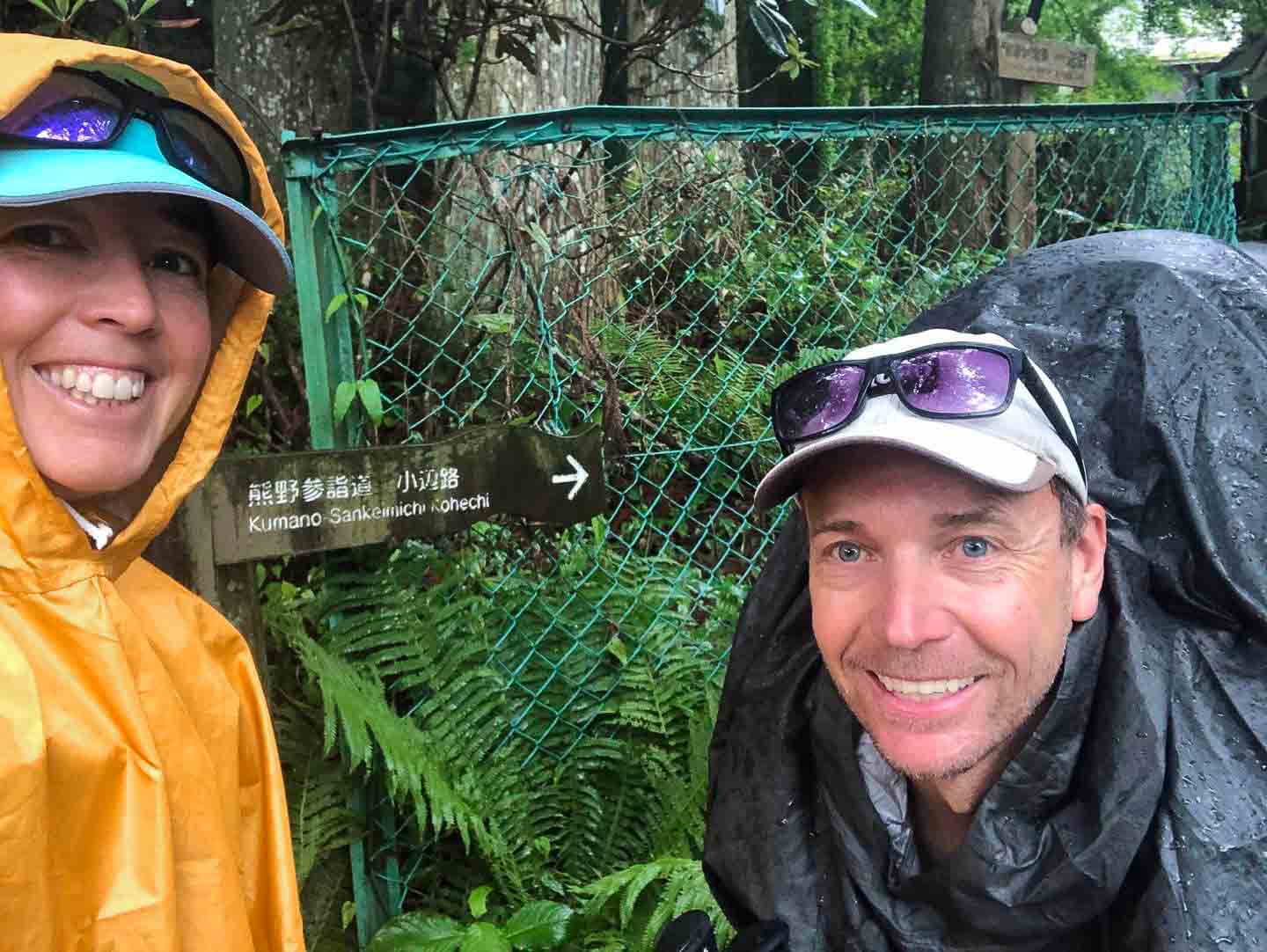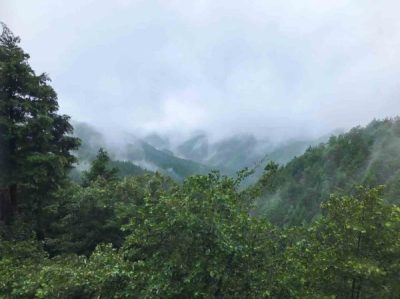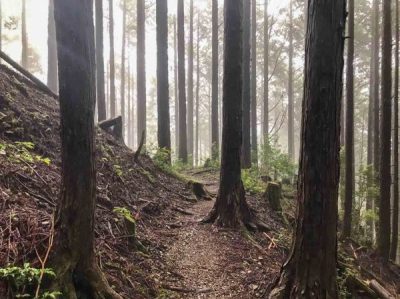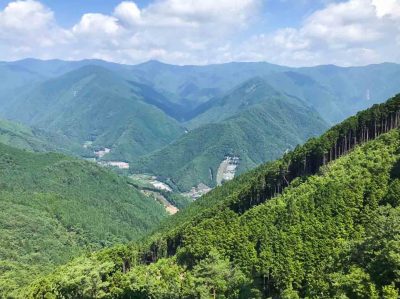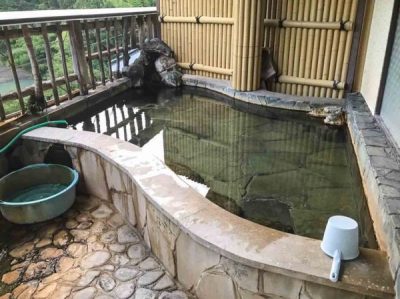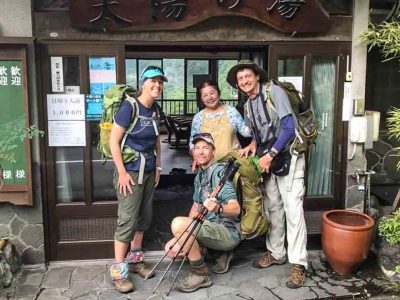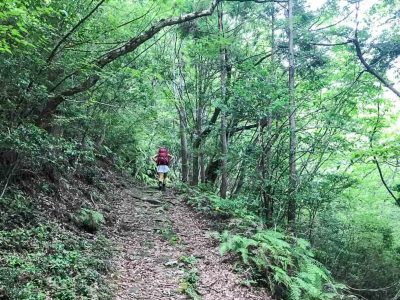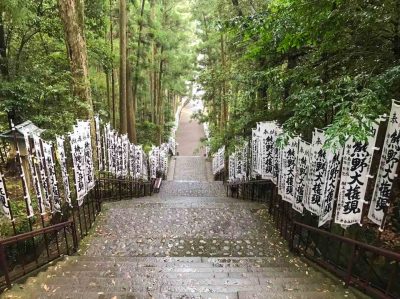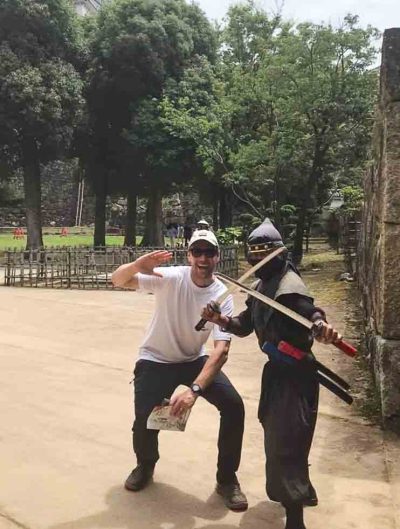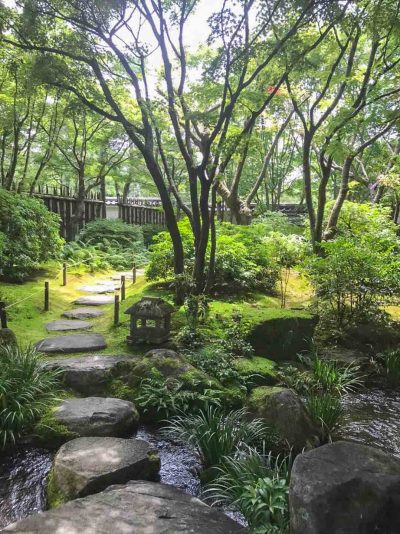Author: Lisa Murphy
The rain belted down as we handed our slippers back to the smiling monks at the temple inn. Our hiking boots were waiting to be fitted onto our feet in the temple entrance where we had stayed in the village of Koyasan, the starting point for our Kumano Kohechi Pilgrimage. About an hour or so earlier we had sat in the temple and witnessed an incredible fire ceremony with monks during morning prayer. The thrum of the drums and chanting of the monks and followers echoed in my mind. I felt cleansed, comforted, and excused from my working life to commence this pilgrimage. Tears of release had flowed at the freedom I felt along with the monsoon shower we now found ourselves watching as we reached for our boots.
Surrounded by mountains, this part of Japan was at the height of summer and also its wet season. With its own microclimate, the deluge might be short-lived or all day. Time would tell. The humidity though would be a guaranteed 100%.
We popped a rain-cover over my pack, tried the poncho for good measure, and just as we stepped off the landing, the rain stopped. We laughed about this with the monks in broken English and Japanese as we said our farewells and commenced our pilgrimage.
KOHECHI DAY 1 – Koyasan to Omata (18-20km)
The poncho lasted 3 minutes, even with the extra layer, the humidity was stifling. I was better off just getting a bit wet really. We found our start point a few minutes walk from the temple inn and after the customary pre-trek photo, we were on our way.
The Kohechi Route is a lesser-walked pilgrimage trail that is a World Heritage Route of the Kumano Kodo on the Kii Peninsula in Japan. Mountainous, remote, with higher elevations and far less travelled by pilgrims, this Route starts in one of the holiest and most significant places in Japan for Shingon Buddhism – Koyasan.
Being our second time in Koyasan, we visited Okunoin the day before to mark our journey. This site is an incredibly captivating cemetery that is not only filled with shrines of remembrance but also houses the temple where Kobo Daishi rests in eternal meditation. Kobo Daishi is the monk responsible for bringing this type of Buddhism to Japan.
Our trek of course includes plenty of inclines as we make our way up and out of Koyasan. It’s not long before we find ourselves away from the urban fringe and on trails within the forest that house giant earthworms looking for oxygen after the rain, plus enormous toads and baby frogs. Already the more-than-human world makes itself known and we are excited to meet these new little friends as we weave our way sharply down and deep into a valley to cross a river.
It’s a decently steep climb out of said valley, and with the calves warmed up we find ourselves at a small rest stop with our first stamp at Otaki. Like the Nakahechi Route, this trail has stamps with stamp pads for recording each day’s progress into your Pilgrims Passport. We meet our first hiker here from Japan. He sets off ahead of us and we stop to check where we are on the map and decide it’s too early for lunch so we will keep going too.
The trail heads into scrubby forest and we see our first tiny snake (harmless) and so many frogs I accidentally launch one off the trail with my leg as it jumps into my shin as I step forward. Poor thing. The climb is enough to know we are working our way upward to the road that will stay with us until almost the end of our walk today. We know there is a lookout so we aim to have our lunch there and get used to the feeling of bitumen under our feet. In modern times, Japanese pilgrimage routes have become roads in many places, and this route was one that was now connecting villages and towns along the way.
The lookout is a bit overgrown but we stand on the logs to take a couple of photos before tucking into our picnic lunch, a collection of supermarket items we purchased in Koyasan – crackers, cheese, tomatoes and some trail mix. Light, salty and refreshing, it was perfect in the heat. We hear voices coming along the road. I am straining to hear the language – definitely not Japanese but maybe European?
We meet two friendly faces from Belgium and realise there might be a few more sharing the trail with us today after all.
We continue on the road, passing shrines and a Jizo statue, and soon we are winding our way to our first night’s accommodation along the rushing Kawarabi River. It’s over 30 degrees and so humid we could jump in this fast-moving river but the current does look a bit unforgiving. We might also blame the heat for this next part, as we may have tried to check in, dripping in sweat, to the wrong accommodation. Thankfully the gentleman on the desk calls our host who appears a few minutes later to drive us 2km back along the road to our digs for the night!
Minshuku is a type of homestay accommodation that is traditionally Japanese and often is the same house and home as the family hosting you for the night. Bedrooms are separated by walls, or sliding doors and the beds are traditional Japanese futon on the floor. Meals are taken in a shared space with other guests and the toilets and showers are also shared. It is all part of the experience and with language barriers and Google Translate, it makes for a fun stay of cross-cultural connection.
After a cold shower, we skip the option of an onsen at the hotel down the road (ironically the one we tried to check in at) and instead, we choose to rest knowing dinner is not far away. And what a feast it is!
The heat has taken it out of these bodies which are accustomed to winter in South Australia, and we retire early to ready ourselves for a big day tomorrow.
KOHECHI DAY 2 – Omata to Miura-Guchi (16-18km)
The sun rises early around 5 am and while it’s too early to get walking, we are up early anyway, exploring the riverbank and drinking tea. Green tea in Japan is less bitter and far more palatable than what we are used to at home. A big Japanese-style breakfast fills our bellies with fish, egg, rice and vegetables. Wanting to beat the heat, we head off by about 8 am into the misty mountains. It was a mystical day of climbs through pine forests and views that closed in around us with clouds and mist. At Hinoki-toge Pass, a gentle rain baptised us reaching this first high point as we leaned our bags against the trail marker and took a snack. The light continually changed as we silently meandered on the trail lost in our thoughts. We spotted deer, toads, frogs, and beetles while we reacquainted ourselves with our old friends, the trees. It was a truly stunning section of forest away from the roads and villages.
We lunched out of the rain in a shelter at Obako-toge Pass, the mist was quite thick and almost disorientating. Looking up a steep incline, this was the only way we could move forward. It was marked DETOUR and we had no choice but to go up as the existing trail was closed due to a landslide.
This detour though was up and over Obako Peak instead of around it. This was by far the steepest section – up and then down, as well as back to the original trail. My legs were definitely unhappy about this little change in plans, but there was no point getting upset, it was a long way back to Omata where we had started!
The forest continued to soothe my mind while my legs battled out the rest of the day content in the mostly downhill terrain, with the odd little steep uphill just to keep us on our toes. Passing teahouse remains and sliding our way on some slippery stones, we popped out on a road where a short walk over a bridge and through a tunnel took us to our accommodation in Miura Guchi. It was a tough day but wow what a stunning trail. A layer of fear about the difficulty of this trail had melted away as we arrived safely and just a bit tired after another big day.
Again, Japanese hospitality awaited with a large delicious Japanese dinner and, with the company of the two hikers from Belgium, an evening of laughs and charades with our hosts ensued. With no Google Translate, we all had a go at guessing what was being shared with us in Japanese.
We hit the hay but sleep was hard to find. It was warmer, louder, and sometimes you can’t sleep no matter how tired you are! Despite this, we still rose fairly bright about the day ahead. A slightly easier/longer walking day perhaps? We sat down to a good-sized breakfast and coffee – our first cup in a couple of days and it couldn’t have been more welcome. Having confessed our caffeine addiction over dinner the night before, I nearly teared up at the idea of a black coffee after a sleepless night. Ah, life’s simple joys.
I practically danced my way along the road as we waved goodbye to our lovely host in our smelly garb with sunshine overhead.
KOHECHI DAY 3 – Miura-Guchi to Totsukawa (20km+)
It was hot already and barely 8.30 am. Finding the trail was a little tricky out of Miura Guchi, but soon we found ourselves deep in the forest, meeting cypress pines over 500 years old and enjoying a gentle climb uphill to the pass. Time seemed to fly with the clear blue skies allowing us sweeping vistas of the valley we had come from.
Once at the pass we crossed a forest road and started the gentle downhill on soft pine needles that offered a cushioned trail weaving past waterfalls, freshwater crab (unfortunately dead), and more ruins. We lunched at a spot where a Buddha and Kannon Statue are housed in a small shrine. We left a pine cone as a sign of respect but later discovered that we could have rubbed Buddha’s head and asked for any ear disorders to be remedied.
The remaining downhill section led us to bitumen road where we then took a wrong turn due to the markers being in Japanese only and also slightly wrong in direction. Our friends from Belgium also took the same wrong turn and we bumped into them when we both realised we were on the right track again. Phew! This next section would be 8km of road and by this stage, it was 2pm and HOT!!
We passed a little store and realised they had ice cream, so we doubled back and enjoyed the highlight of this road-walk. And did we need it! It was the hottest section of trail thus far and we had a couple of extra km’s to our accommodation which meant about 10km all up. The nice part of this road-walk was being by the Kannogawa River and following it virtually to our accommodation in Totsugawa Onsen. With no signs in English, it was a challenge to find and perhaps an extra 45 minutes of searching (and frustration) but when we heard our friends from Belgium laughing from above in their outdoor onsen, we knew we had reached the right place.
This accommodation was an absolute gem. There were 6 floors plus 3 floors with private outdoor onsen on the balcony overlooking the river. We had reached pilgrim Utopia! With very weary bodies after three days on the trail, and those last 10km on road (which was harder than any pass we had undertaken so far oddly), this onsen is one I will not forget in a hurry.
Our hosts here were so attentive. Using Google Translate to start conversations and serve us the most incredible meals, it was a really homely experience. Sleep came easily and heavily.
KOHECHI DAY 4 – Totsukawa to Hongu (18km+)
A final day with one giant climb lay ahead. Our good friend and guide, Mike, was joining us for this section and he was a fabulous distraction as we negotiated the uphill to Hatenashi-toge Pass. The village of Hatenashi is said to be one of the healthiest locations in Japan for air and water quality. With views across the rice paddies and a field of sunflowers, it’s not surprising. Overlooking Totsukawa, the village also marks the start of thirty Kannon statues that countdown not just the climb to the pass but all the way into Hongu. There are an extra 3 statues just off the trail at Hatenashi, but we talk way too much and lose time taking photos and bantering. The breaks are needed though to catch the breath, this climb is virtually all uphill for the morning. My legs are undeniably tired and with stiff knees, I take a lot longer to get there.
We make it over the pass, celebrating with snacks and electrolytes before the downhill and knowing we are about 2.5 hours from Hongu (and ice cream). Another hot and humid day with blue skies that eventually turn overcast. By the time we finish lunch on our way down and approach Hongu, the rain starts. But we keep talking, its soo good to catch up after years of separation thanks to the COVID pandemic. We do take moments in respectful silence, space to take it all in and hold gratitude.
Hongu presents the gifts of ice cream and every sugary boost needed to face the final kilometres to the Grand Shrine. We say farewell to our friends from Belgium who also find the same store as us and we return to the trail in the rain with distant thunder. Right before we reach the Shrine, Mike points out a mamushi (viper) snake with its distinct pattern. It’s beautiful.
The Shrine had just closed as we grabbed our final pilgrim stamp with a peaceful moment to reflect on completing our Kohechi trek. The stairs were deserted as we made our way down and bowed with mixed feelings for the pilgrimage to be over.
What a blessing to walk this trail in all the conditions, both challenging (heat, humidity, rain, elevation) and rewarding (onsen, Japanese cuisine, airconditioned bedroom). We only met 3 other hikers plus Mike on our journey. Those days of solitude and company were so delicately balanced.
My legs were grateful for the rest after 4 long walking days but my heart and mind were grateful for the trails – the forest, the wilderness, the mountains, the peace.
We finished our time in Japan with a fabulous couple of days in Yunomine Onsen village and Himeji, sister city to our hometown, Adelaide. A gentle wander around Koko-en gardens, Himeji castle, a little fun with ninjas, and being awestruck by the giant trees – a wonderful way to recover from an incredible trek!
This Route is best completed guided, with a very good level of hiking and hill fitness as it is marked in English most of the time but only Japanese in many places. It includes brilliant passes through the mountains and is considered remote.
Eager to learn more about Japan’s Kumano Kodo Routes, and understand the differences between our Kohechi and Nakahechi trips? Stay tuned for another blog post coming soon!
Additional Reading
Big Heart Adventures is a commercial tour operator (CTO) and lead walking adventures along the two Kumano Kodo Pilgrimage Routes in Japan – Kohechi and Nakahechi, including a Women’s Kumano Kodo.
We also offer many more walking adventures throughout Australia and overseas. Choose between fully guided walking tours and self-guided walking adventures.
Read more about ‘Big Heart Adventures’ and wellness walks, plus our commitment to accessiblity.


